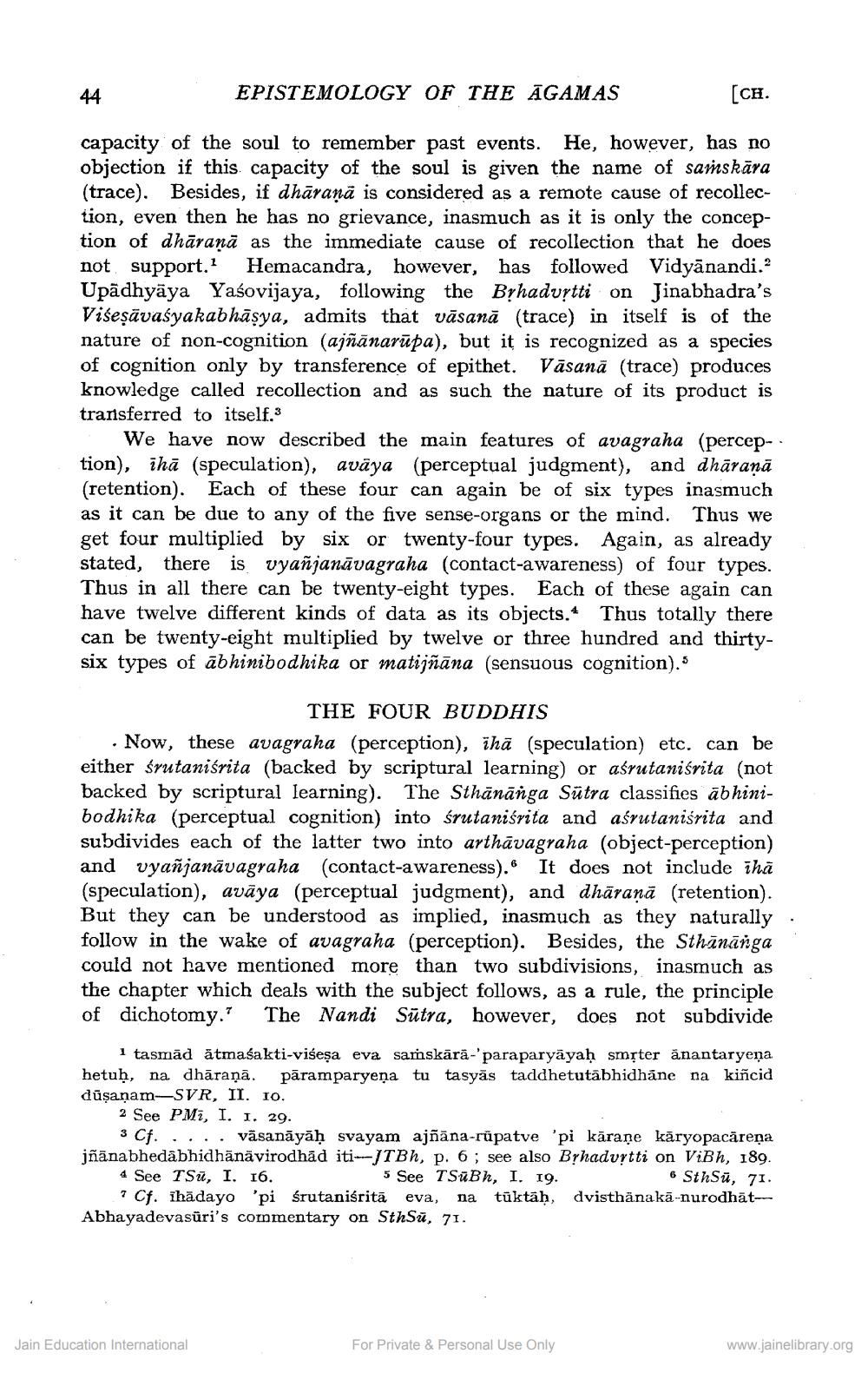________________
[CH.
capacity of the soul to remember past events. He, however, has no objection if this capacity of the soul is given the name of samskāra (trace). Besides, if dharana is considered as a remote cause of recollection, even then he has no grievance, inasmuch as it is only the conception of dharaṇā as the immediate cause of recollection that he does
44
EPISTEMOLOGY OF THE AGAMAS
not support.1 Hemacandra, however, has followed Vidyānandi.2 Upadhyaya Yaśovijaya, following the Brhadvṛtti on Jinabhadra's Viseṣāvasyakabhāṣya, admits that vāsanā (trace) in itself is of the nature of non-cognition (ajñānarūpa), but it is recognized as a species of cognition only by transference of epithet. Vāsanā (trace) produces knowledge called recollection and as such the nature of its product is transferred to itself.3
We have now described the main features of avagraha (percep-tion), ihā (speculation), avaya (perceptual judgment), and dhāraṇā (retention). Each of these four can again be of six types inasmuch as it can be due to any of the five sense-organs or the mind. Thus we get four multiplied by six or twenty-four types. Again, as already stated, there is vyañjanavagraha (contact-awareness) of four types. Thus in all there can be twenty-eight types. Each of these again can have twelve different kinds of data as its objects. Thus totally there can be twenty-eight multiplied by twelve or three hundred and thirtysix types of abhinibodhika or matijñāna (sensuous cognition).
THE FOUR BUDDHIS
. Now, these avagraha (perception), iha (speculation) etc. can be either śrutaniśrita (backed by scriptural learning) or aśrutaniśrita (not backed by scriptural learning). The Sthānanga Sutra classifies abhinibodhika (perceptual cognition) into śrutaniśrita and aśrutaniśrita and subdivides each of the latter two into arthavagraha (object-perception) and vyañjanavagraha (contact-awareness). It does not include iha (speculation), avaya (perceptual judgment), and dhāraṇā (retention). But they can be understood as implied, inasmuch as they naturally follow in the wake of avagraha (perception). Besides, the Sthānanga could not have mentioned more than two subdivisions, inasmuch as the chapter which deals with the subject follows, as a rule, the principle of dichotomy." The Nandi Sutra, however, does not subdivide
1 tasmād ātmasakti-viśeşa eva samskärä-'paraparyayaḥ smṛter änantaryeņa hetuḥ, na dhāraṇā. pāramparyena tu tasyas taddhetutabhidhāne na kincid dūṣaṇam-SVR, II. 10.
2 See PM, I. 1. 29.
3 Cf.
... vāsanāyāḥ svayam ajñāna-rupatve 'pi kāraṇe karyopacāreņa jñānabhedabhidhänävirodhad iti-JTBh, p. 6; see also Bṛhadvṛtti on ViBh, 189. 4 See TSu, I. 16. 5 See TSüBh, I. 19.
6 SthSu, 71.
dvisthänaka-nurodhāt
Cf. ihādayo 'pi śrutaniśritā eva, na tüktāḥ, Abhayadevasüri's commentary on SthSu, 71.
Jain Education International
For Private & Personal Use Only
www.jainelibrary.org




